
The Trouble with Modern Greens
During my recent golf trip to central Oregon, I had the opportunity to play Tetherow Golf Club [review HERE]. This David McLay-Kidd design features very large greens. This led me to an interesting question: do the large greens favored by modern architects negate the value of greens in regulation?
Get caught up on the first ten installments of the Course Management Basics series HERE.
This Lesson Is For You If:
You play courses with large greens

The King of Stats
Greens in regulation (GIR) is the king of golf stats because it’s the one that correlates most closely with handicap. If you hit about 7 GIR per round, you’re likely to be a single digit handicap. Hit 10 or more and you’re flirting with scratch. But do the benefits of hitting lots of greens diminish when you playing on larger greens?
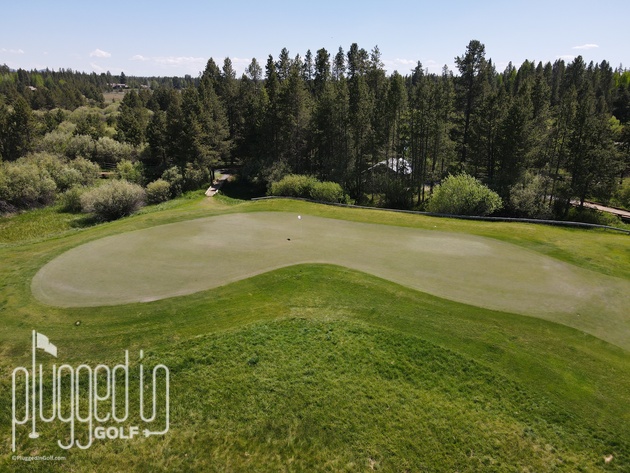
The Data
First, thank you to Shot Scope for providing the data for this lesson. Their data is pulled from millions of shots hit by thousands of golfers of all handicap levels. If you want to start tracking your shots and playing smarter golf, click HERE.
If we were to boil this down to one number, it would be 30 feet. That’s how much closer you need to be to negate the benefits of being on the green. Golfers who are 21 feet from the flag and off the green require slightly fewer strokes to finish (between 0.04 and 0.17, depending on handicap) than golfers who are on the green but 51 feet away from the cup.
What is the benefit to being on the green? That depends on the handicap. Comparing like distances – 21 feet from the hole – on and off the green, the difference in strokes to finish is 0.22 for scratch players. For those with handicaps of sixteen or more that jumps to almost 0.5 strokes. While this highlights how much better scratch players’ short games are, it also indicates what a massive advantage it is to be on the green.
Before moving on, let’s spell out the two obvious inferences. First, if you’re off the green but more than 30 feet closer, that’s a win. If 30 feet closer confers a small advantage, being 50 feet closer should give us an even larger advantage. Conversely, if you can’t get at least 30 feet closer, just get your ball on the green.
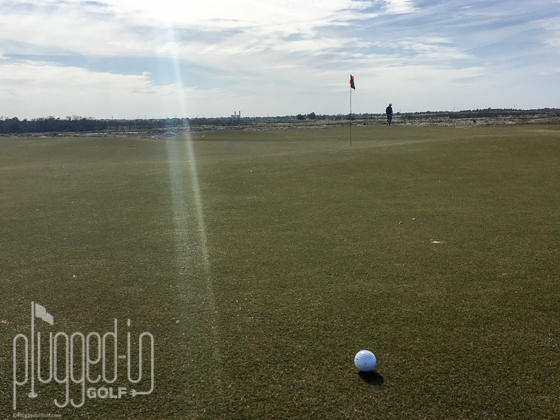
Real World Application
Obviously, golfers do not get to stand in the fairway and decide between being 51 feet away on the green or 21 feet away in the fringe. They need to hit shots that will have a variety of possible outcomes. Because there are so many variables in play – the size and shape of the green, pin location, hazards, shape and texture of the surrounds, the player’s tendencies, etc – I can’t give you a single, simple rule for how to play. Instead, here are a handful of things to consider so you can make the best decision for your game.
Note: these ideas are listed in order of importance. If you’re a newer player, or simply trying to play smart for the first time, start with one or two. When those ideas become second nature, add more.
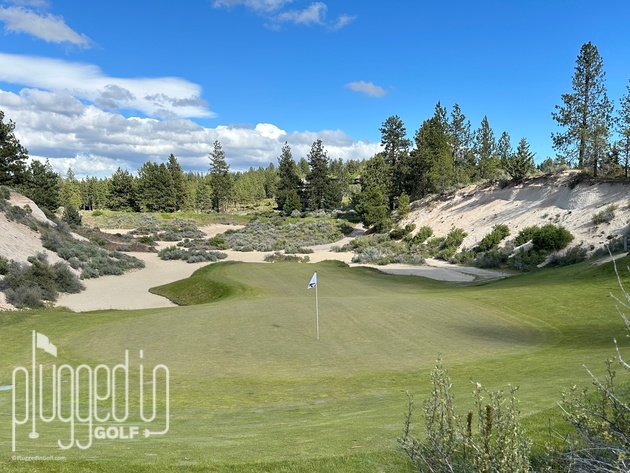
“Shotgun, Not Sniper Rifle”
I’ve discussed this concept before, but it bears repeating. Scott Fawcett, creator of the Decade Course Management System, is responsible for the phrase, and I think it’s the one thing that will make every golfer a better player instantly.
What he’s saying is that your golf clubs create a shot pattern that covers a certain area. Depending on the club and your skill level, that pattern will change in size and shape, but it’s never a single dot. You need to think about placing the entire shot pattern safely when you pick a target. Keep this in mind from tee to green, and you’ll start making better decisions.

Eliminate Hazards
Whether we’re playing on big greens or small greens, staying out of hazards is essential to scoring well. We need to be aware of OB, water, sand, and less obvious hazards like steep depressions or areas with tall grass where we might lose a ball.
Keeping the ball out of trouble sounds obvious, but it requires discipline. When the flag is on the side of the green near a hazard, you need to move your whole shot pattern away from it. That can be tough, but it will pay off in the long run.
Here’s another stat from Shot Scope that will help you stay on the disciplined path: 0.52. That’s the average penalty, across all handicap levels, for hitting into a greenside bunker. Keep in mind that number does not assume that you’re getting a GIR, simply that you stayed off the beach. Bunkers, especially for higher handicap players, are a major driver of higher scores.
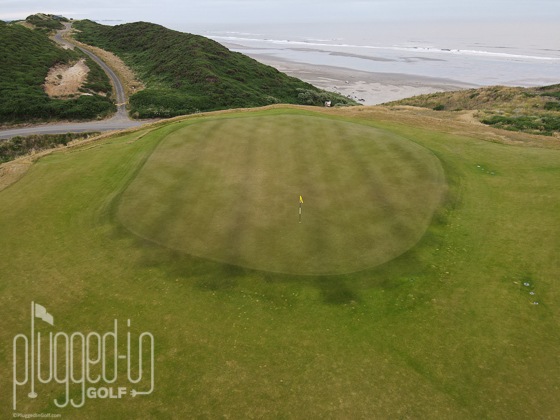
Green Undulations
Generally, these big greens that we’re discussing are also full of sharp undulations and steep tilts. They also tend to play firmer and faster. This has a couple implications. First, you need to hit your approach high and soft or plan for some amount of roll out. Second, the ball is likely to move once it’s on the ground.
This second point is my focus. Consider the green above. This is an upside-down saucer or turtleback green that runs off in every direction. The day this picture was taken, the pin position on the front was fairly friendly – a little long is fine, and short leaves you a simple chip. But what if the pin was near the back edge? The average golfer would play the flag number, hit a “good” shot, and then watch their ball run off the edge of the world.

Before hitting your approach shot, consider where your ball is going to land and where it will roll to. If certain landing spots will roll into hazards or end up miles from the pin, try to remove those landing spots from your shot pattern.
We can also consider using the green’s slopes to our benefit. The green above is #18 at Sedge Valley [review HERE]. You can see how it has friendly banks on both the left and right side of the mouth of the green. This is a smaller green, so those banks won’t impact where we place our shot pattern. On a larger green, however, these features could allow us to pick a more aggressive target, knowing that a shot that’s a little left will be shoved back toward the middle.
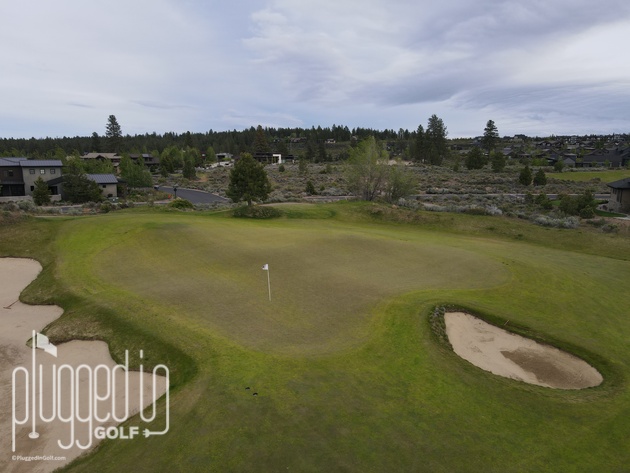
Evaluate the Surrounds
Whether the greens are big or small, we should also take a look at the undulations in the surrounds. On small greens, we should consider this because part of our shot pattern is likely to be off the green. With larger greens, we should think about the surrounds because they might be a better place than the far reaches of the putting surface.
As a general rule, we’re thinking about the same things that we did on the green: if my ball lands in a certain area, will the slopes make things better or worse? Where will my ball finish? Will this lead me to a hazard, closer to the pin, or farther away?
Let’s look at a couple examples from Tetherow to illustrate. In the photo above, we can see that the green is heavily segmented – any long putt is going to be tough. But are any of the surround areas better? No. Closest to the flag, the surround falls away steeply. The same is true on the right side (from our perspective). There is some fairly safe space on the far side of the green, but it’s narrow. In this case, we’re better off playing for the center of the green and accepting that we might have to navigate some challenging putts.

In contrast, the green above has a very mild surround, with the exception of the bunkers. With the flag all the way back, the center of the green is probably the best play. However, if the flag was in the front or middle, we should take advantage of the flat surround on the front side to eliminate the sand from our shot pattern.
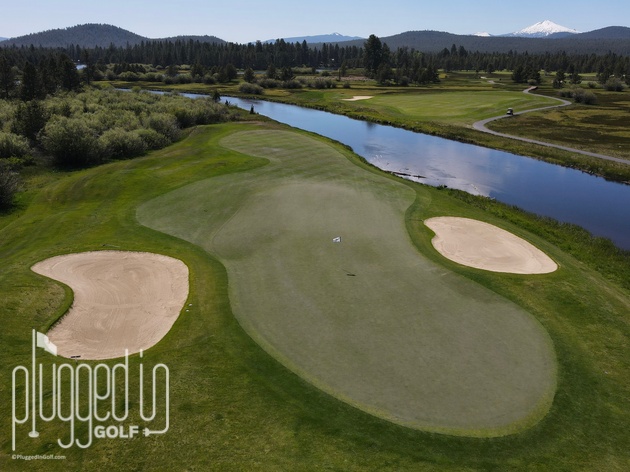
Is Flag Hunting Good Again?
“Flag hunting” or “pin hunting” are terms used to describe aggressive play and, often, poor course management. In the amateur context, I use them almost exclusively negatively, talking about players who shoot the flag with their rangefinder and play that number with no regard for anything else. But, with larger greens and our 30 foot rule, is flag hunting the way to play?
The short answer is, “No.” As we’ve just discussed, there are a myriad of factors we should be considering before picking a target. So while the flag may end up being a good aiming point, it’s never a good idea to aim at the hole without regard for anything else.
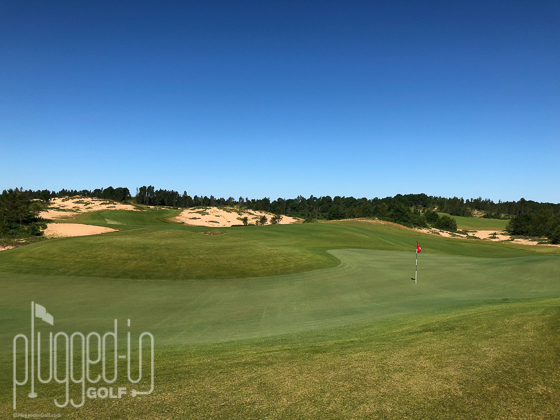
Is the Middle of the Green Ever Bad?
Again, the short answer is, “No,” but we can offer a little more depth and nuance.
The average green is somewhere in the neighborhood of 5,000 square feet. If we assume a fairly normal shape, that’s about 70 feet on each side. From 85-115 yards, the average 15 handicap has a dispersion that’s around 90 feet left-to-right and front-to-back. All that to say, with a wedge in their hand, a 15 handicap should probably aim for the middle of the green and be happy with any GIR. That’s why many pros and coaches have said some variation of, “The middle of the green never moves” or “The middle of the green is never bad.”
It gets a little more complicated when we get to large greens or greens with unusual shapes. Take the boomerang-shaped green at Mammoth Dunes (above): should we be aiming for the skinniest part of the green because it’s the middle? For most pin positions, the answer is probably no.
When you’re in doubt about the value of the middle of the green, remember what we’ve discussed here. Consider your whole shot pattern. Avoid hazards. Think about what the ball will do when it lands. Follow those three steps, and you’ll see your scoring improve.
Find more Course Management Basics HERE
He founded Plugged In Golf in 2013 with the goal of helping all golfers play better and enjoy the game more.
Matt lives in the northwest suburbs of Chicago with his wife and two daughters.
- Performance Golf Click Stick Training Aid Review - October 18, 2024
- Callaway Opus Platinum Wedge Review - October 17, 2024
- When to Take a Break from Golf - October 15, 2024



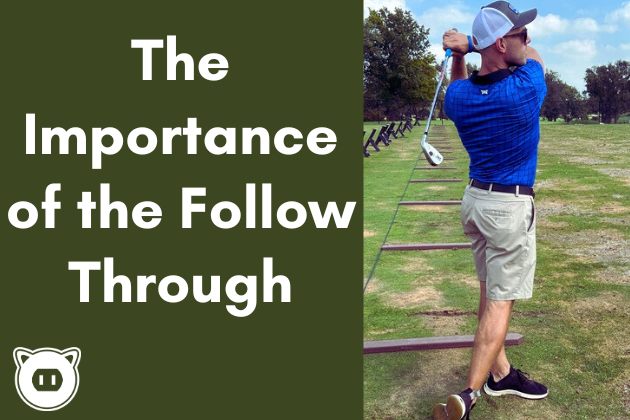
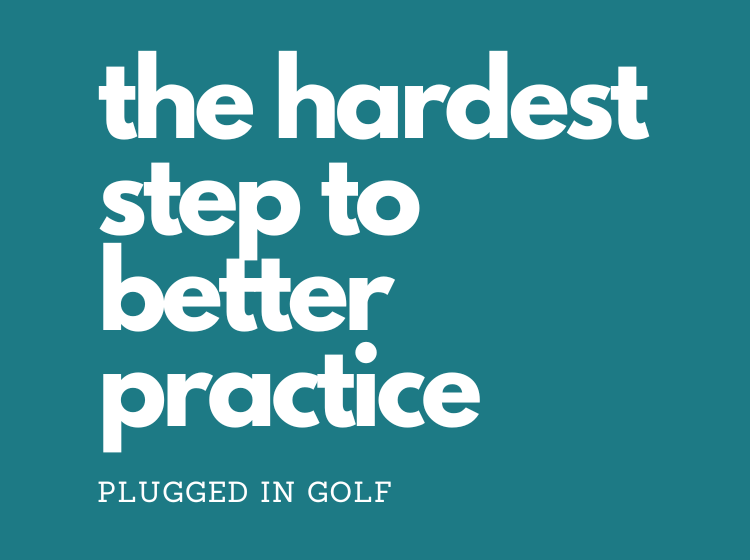









4 Comments
Hmm maybe we need a new stat, let’s call it “QSS” .. Quality of Scoring Shot .. which takes into account: [ GIR + proximity + (SG adjusted for ball landing position & player handicap) ]
I think Strokes Gained does a pretty good job of taking all that into account, it’s just not something a golfer can calculate without an app like Shot Pattern.
Best,
Matt
Great article. I’ve been thinking recently, as a high hcp (24), could it make sense to lay up just short of the green if it is protected on multiple sides? Being just short of the green could pay off more than being in a green side bunker as per your stat above about added strokes coming out of the sand. Any thoughts?
George,
That’s a really interesting question. My off the cuff thought is this: aiming short of the green feels safe, but you have to realize that you’re not any more accurate trying to be short of the green than you are trying to hit the green (maybe you’re a little more accurate because it might be one less club, but let’s call it a wash for the sake of discussion). That means that if you aim for the front edge, you’re going to be on the green when you’re long (statistically rare), a little short when you’re accurate, and way short when you’re short (very common for most golfers). And that ignores left and right.
All that to say: I’d aim for the center of almost every green and take all the GIRs I could get, especially as a 24.
Best,
Matt